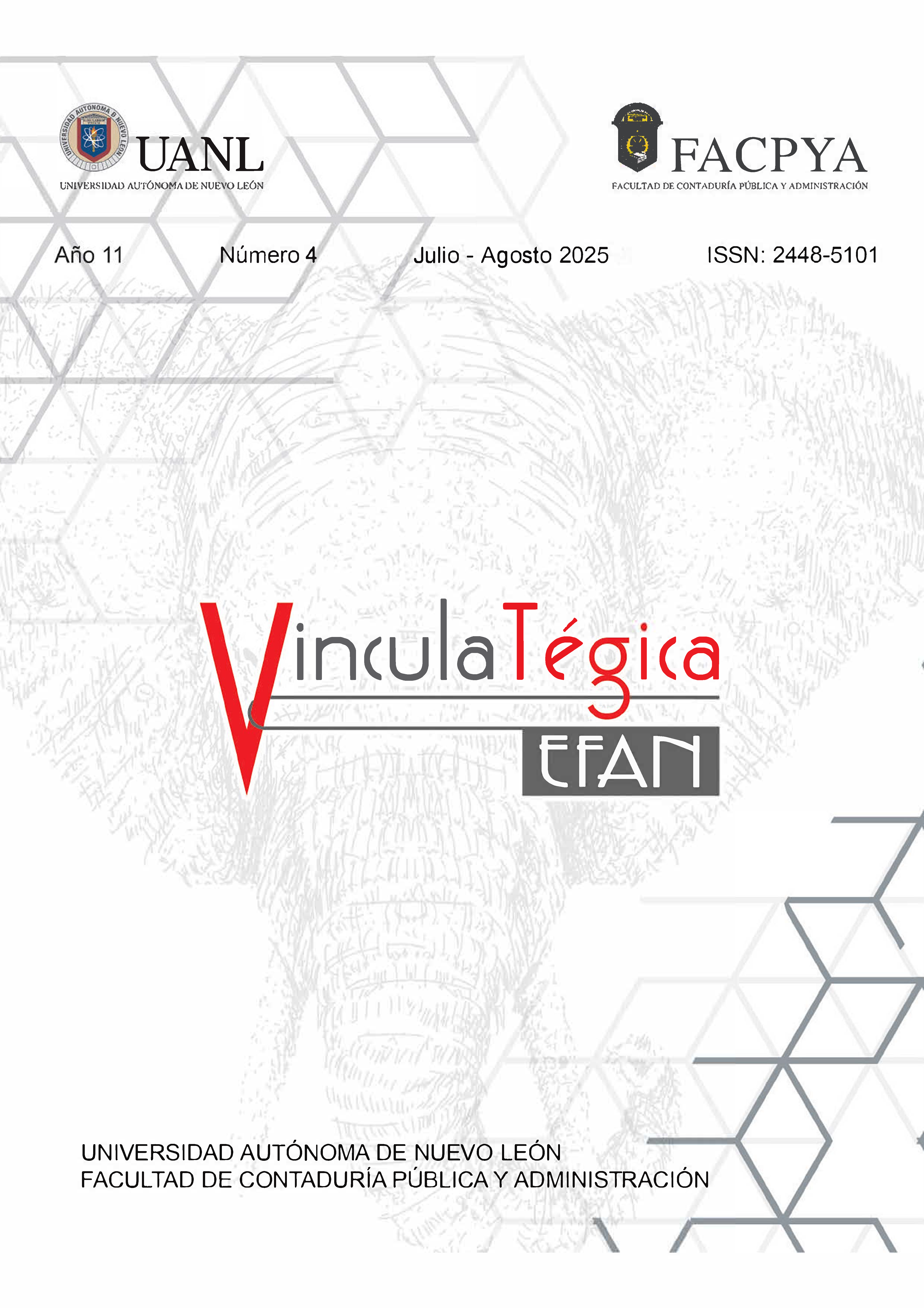Marketing Digital y Lealtad del Cliente en Pymes Restauranteras de Ciudad Victoria, Tamaulipas
DOI:
https://doi.org/10.29105/vtga11.4-1188Palabras clave:
Lealtad, Marketing, Marketing digital, Redes sociales, RestaurantesResumen
La presente investigación analiza la relación entre el marketing digital y la lealtad del cliente en pequeñas y medianas empresas (Pymes) restauranteras de Ciudad Victoria, Tamaulipas. El estudio aborda la dificultad de estas organizaciones para generar y mantener clientes leales mediante un uso estratégico de las redes sociales, considerando que retener clientes existentes es más rentable que atraer nuevos consumidores. Se utilizó una metodología cuantitativa, con alcance correlacional y diseño transversal, aplicando un instrumento a 382 personas económicamente activas que interactúan frecuentemente en plataformas digitales. El modelo propuesto se basa en las “4 F's” del marketing digital (flujo, funcionalidad, feedback y fidelización) y en la dimensión actitudinal de la lealtad del cliente, facilitando un ecosistema digital centrado en la confianza y la interacción. Los resultados evidencian un impacto positivo y significativo de flujo, funcionalidad y fidelización en la lealtad actitudinal, lo que revela una mayor predisposición de los consumidores a mantener relaciones duraderas con las Pymes restauranteras estudiadas. Se concluye que la adopción de estrategias de marketing digital, junto con la mejora continua de las interacciones y la satisfacción del cliente, es esencial para fortalecer la lealtad y la competitividad en este sector.
Descargas
Citas
American Marketing Association, (2017).
Argüelles Montero, D. C. (2020). Estrategias de marketing digital de la industria restaurantera en la ciudad de Chetumal (Bachelor's thesis, Universidad de Quintana Roo).
Bernal, C. A. (2010). Metodología de la investigación: administración, economía, humanidades y ciencias sociales. (3 Edic.). Colombia: Prentice Hall, 160-161.
Cabezas, E., Andrade, N., y Torres, J. (2018). Introducción a la metodología de la investigación científica (1ra ed.). Ecuador: Universidad de las Fuerzas Armadas.
Cazau, P. (2006). Introducción a la investigación en Ciencias Sociales (3ra ed.). BuenosAires.
Chaffey, D., Ellis-Chadwick, F., & Mayer, R. (2009). Internet marketing: strategy, implementation and practice. Pearson education.
Choquepata, J., & Molina, J. (2020). El marketing digital en redes sociales como herramienta para influenciar en la decisión de compra de clientes de restaurantes de comida rápida. Repositorio Institucional- UTP.
Córdoba-López, J.F. (2009). Del marketing transaccional al marketing relacional. Entramado, 5(1), 6-17. https://bit.ly/2XNnLiN.
Cudriz, E. C. N., & Corrales, J. D. M. (2020). El marketing digital como un elemento de apoyo estratégico a las organizaciones. Cuadernos Latinoamericanos de Administración, 16(30). DOI: https://doi.org/10.18270/cuaderlam.v16i30.2915
Cvetković Vega, A., Maguiña, J. L., Soto, A., Lama-Valdivia, J., & Correa López, L. E. (2021). Cross-sectional studies. Revista de La Facultad de Medicina Humana, 21(1), 164–170. https://doi.org/10.25176/rfmh.v21i1.3069. DOI: https://doi.org/10.25176/RFMH.v21i1.3069
Dick, AS, y Basu, K. (1994). Lealtad del cliente: hacia un marco conceptual integrado. Revista de la academia de ciencias del marketing, 22, 99-113.
Duque, D. A. S., Santos, J. L. Q., & Galarraga, F. J. M. (2016). Criterios de medición en la lealtad del cliente aplicados a restaurantes de la ciudad de Quito. Gran tour, revista de investigaciones turísticas, (14).
Fleming, P. (2000). Hablemos de marketing interactivo. Reflexiones sobre marketing digital y comercio electrónico. Esic Editorial. https://books.google.es/books?hl=es&lr=&id=FjI5ZXro_sC&oi=fnd&pg=PA17&dq=Hablemos+de+marketing+interactivo+paul+fleming+2000&ots=pUx_mxTisN&sig=LuZByosz9DxR7nHoZm4y8c059As#v=onepage&q=Hablemos%20de%20marketing%20interactivo%20paul%20fleming%202000&f=false.
Galarza, C. A. R. (2020). Los alcances de una investigación. CienciAmérica: Revista de divulgación científica de la Universidad Tecnológica Indoamérica, 9(3), 1-6. DOI: https://doi.org/10.33210/ca.v9i3.336
Garzón Valdéz, G. Y., Ruiz Santoyo, G. A., & Juárez López, B. (2020). Análisis de la confianza, lealtad e intención de compra digital de los consumidores post-millennials. Revista Espacios, 41(34).
González-García, G., Becerril Carbajal, M. L., & Fonseca Munguía, A. (2018). El engagement como factor de formación y desarrollo de la cultura emprendedora en estudiantes universitarios. IE Revista de Investigación Educativa de la REDIECH, 9(17), 103-118. DOI: https://doi.org/10.33010/ie_rie_rediech.v9i17.120
González G.M., Medina Q. J.M. y Sánchez L. M. L. (2015). Las redes sociales: herramienta de mercadotecnia para el sector restaurantero. Artículos de investigación producto de proyecto de investigación formativa, vol. 11 Núm. 20. https://revistas.poligran.edu.co/index.php/poliantea/article/view/650. DOI: https://doi.org/10.15765/plnt.v11i20.650
Hair, J.F. (2011). Multivariate Data Analysis: An Overview. In: Lovric, M. (eds) International Encyclopedia of Statistical Science. Springer, Berlin, Heidelberg. https://doi.org/10.1007/978-3-642-04898-2_395. DOI: https://doi.org/10.1007/978-3-642-04898-2_395
Hair, J. F., Black, W. C., Babin, B. J., & Anderson, R. E. (2010). Advanced diagnostics for multiple regression: A supplement to multivariate data analysis. Advanced diagnostics for multiple regression: A supplement to multivariate data analysis, 900.
Hair, J. F., Bush, R. P., & Ortinau, D. J. (2010). Investigación de mercados: en un ambiente de información digital. México, DF: McGraw-Hill.
Howard, J.A. (1974): “The structure of buyer behavior”. Consumer Behavior: Theory and Application, Farley, J.V. y Howard, J.A. (eds.), Boston, MA: Allyn & Bacon, pp. 9-32. Howard, J.A. y Sheth, J.N. (1969): The Theory of Buyer Behavior, New York: John Wiley and Sons.
Jacoby, J., Chestnut, R. W., & Fisher, W. A. (1978). A behavioral process approach to information acquisition in nondurable purchasing. Journal of marketing research, 15(4), 532-544. https://doi.org/10.1177/002224377801500403 DOI: https://doi.org/10.1177/002224377801500403
Kotler, P. & Armstrong, G. (2013). Fundamentos de marketing. Decimoprimera edición. https://frrq.cvg.utn.edu.ar/pluginfile.php/14584/mod_resource/content/1/Fundamentos%20del%20Marketing-Kotler.pdf
Lee, N., Broderick, A. J., & Chamberlain, L. (2007). What is ‘neuromarketing’? A discussion and agenda for future research. International journal of psychophysiology, 63(2), 199-204. DOI: https://doi.org/10.1016/j.ijpsycho.2006.03.007
López Montoya, L. M., Lozada Caldono, M. F., & Martínez Manzano, G. (2018). Plan de negocio para la creación del restaurante de comida típica" El Fogón de Doña Irene" en la ciudad de Cali.
Martins, F., & Palella, S. (2003). Análisis de las estrategias instruccionales empleadas por los profesores del área de matemática.: caso: universidad simón bolívar. sede litoral. Investigación y Postgrado, 18(1), 71-85.
Meléndez, M. P. S. (2018). El marketing digital transforma la gestión de Pymes en Colombia. Cuadernos latinoamericanos de Administración, 14(27). DOI: https://doi.org/10.18270/cuaderlam.v14i27.2652
Montenegro, G. (2021). Evaluación de la lealtad del cliente en el restaurante el Rincón del Pato, Chiclayo–2020. Obtenido de Universidad Católica Santo Toribio de Mogrovejo: https://tesis.usat.edu.pe/handle/20.500.12423/348
Ocaña E. P. M. y Freire A. T. M. (2021). "Impacto de la gestión de redes sociales en las empresas gastronómicas". Artículo de Investigación. https://www.redalyc.org/journal/5717/571770819003/html/#:~:text=IMPACTO%20DE%20LA%20GESTI%C3%93N%20DE%20REDES%20SOCIALES%20EN%20LAS%20EMP.
Pamies, D. S. (2004). De la calidad de servicio a la fidelidad del cliente. ESIC editorial.
Porter, M. (1985). La ventaja competitiva según Michael Porter. Web y Empresas, Administración, Ingeniería, Gestión y mucho más.
Reich L. C. & Barragán C. J. N. (2019). Evaluación comparativa de los ratings en redes sociales y las encuestas internas de la empresa. Caso de estudio: industria restaurantera de Monterrey, México. Daena: International Journal of Good Conscience, 14(1)88-94.
Render, B., Stair, R. M., & Hanna, M. E. (2006). Métodos cuantitativos para los negocios. Pearson Educación.
Saba Córdova, P. J., & Trujillo Saavedra, V. J. (2020). Estrategias de marketing digital empleadas por los restaurantes pyme ubicados en la urb. Miraflores del distrito de Castilla, ciudad de Piura, 2020.
Sabogal Russi, L. F., & Rojas-Berrio, S. P. (2020). Evolución del marketing experiencial: una aproximación teórica a su definición-Revisión Sistemática de Literatura. Entramado, 16(1), 94-107. DOI: https://doi.org/10.18041/1900-3803/entramado.1.6140
Selman, H. (2017). Marketing digital.
Zamora, J., Vásquez, A., Díaz, R., & Grandón, M. (2011). Hacia la comprensión de la lealtad del cliente de restaurantes: Caso Talca, Región del Maule-Chile. Estudios y perspectivas en turismo, 20(3), 563-583.
Zurita-Mézquita E. C., Berttolini-Díaz G., & Barroso-Tanoira F. G. (2020). Redes sociales en la micro, pequeña y mediana empresa. Revista Cubana de Ciencias
Descargas
Publicado
Cómo citar
Número
Sección
Licencia
Derechos de autor 2025 Brissa Gabriela Romero-Orozco, Natalia Berenice Sánchez-Rodríguez, José Esteban Mendoza-Flores

Esta obra está bajo una licencia internacional Creative Commons Atribución 4.0.
Los autores que publiquen en la revista VinculaTégica EFAN aceptan el siguiente aviso de derechos de autor:
a). Los autores conservan los derechos de autor y ceden a la revista el derecho de la primera publicación de la obra bajo una licencia de atribución de Creative Commons. Esta licencia permite a otros compartir la obra siempre que se reconozca la autoría original y la publicación inicial en esta revista.
b). Los autores pueden establecer acuerdos contractuales adicionales de manera independiente para la distribución no exclusiva de la versión publicada en la revista (por ejemplo, publicarla en un repositorio o incluirla en un libro), siempre que se reconozca la publicación inicial en esta revista.
c). Se permite a los autores autoarchivar su trabajo en repositorios institucionales o en su propio sitio web antes y durante el proceso de envío, ya que esto puede fomentar intercambios productivos y aumentar la citación temprana y general del trabajo publicado.







